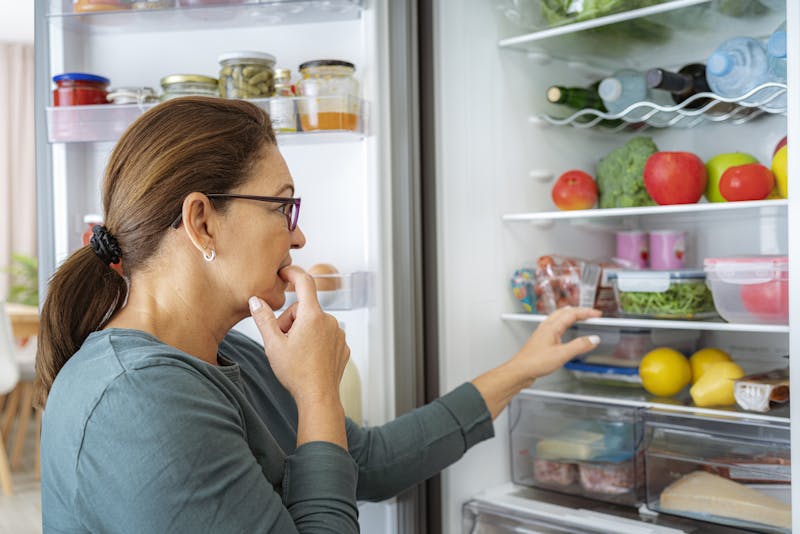
It doesn’t matter what we’re referring to, having a plan saves time, minimizes stress, and increases the likelihood of success. This approach rings true when mapping out your weekly recipes. We understand how busy you are and that you may be planning meals for family members with dietary restrictions and distinctly different food preferences. The tips below help you meal plan like a pro!
Why plan your meals for the week ahead?
If you know what your next meal is going to be, you’ll:
- Reduce stress: Your schedule is busy, and if you have kids, their schedules are just as busy as yours. Reduce stress, particularly the “what’s for dinner stress”, by planning ahead.
- Save time: The time it takes to see what you have in your kitchen and decide what to make wastes time. With a plan, you can get straight to cooking. Save even more time by cooking and prepping what you can in advance.
- Keep things healthy: When you don’t know what to eat, you’re more likely to make less healthy choices. Stocking your fridge, freezer, and pantry ensures healthy ingredients and meals are easily accessible.
- Keep things fun: Setting aside an hour (or less) each week to map out your menu for the week allows time for culinary creativity. You may reserve complex recipes for the weekends, but still—plan ahead.
- Reduce food waste: The most successful plans include eating leftovers, freezing leftovers, and utilizing produce and perishable foods before they go bad.
What is a meal plan?
Meal planning is more than a grocery list, it’s a strategy. Every week is different, so you won’t always need to plan meals for everyone. For example, you might have dinner with clients, your partner may have brunch with friends, and your kids may spend the night with a friend. You’ll also need to plan for having guests over to eat.
- Meal list: Determine what meals you need to pack or prepare for yourself, family members, and guests.
- Nutrient diversity: Ensure you and your family consume a diverse range of micronutrients and macronutrients.
- Tailored recipes: Hand-pick recipes that are delicious, nutritious, and tailored to support your lifestyle, health, and wellness objectives.
Now let’s dive into tips that accelerate planning.
#1 Upgrade or invest in kitchen equipment
The right kitchen tools and appliances help make cooking more efficient and more fun. More delicious and nutritious too!
- Standard essentials: Consider upgrading knives, blender, pots, pans, and preferred kitchen essentials.
- Storage essentials: Invest in fridge and freezer containers and insulated food and beverage containers.
- Sheet pan: Sheet pan recipes are fast, easy, and healthy, often taking 10 minutes or less to prep.
- Automated appliances: An air fryer, Instant Pot, grain cooker, food steamer, automatic coffee maker, and other appliances accelerate cooking.
#2 Plan to minimize food waste
Start planning with the meals you and your family want for the week, then identify how many perishable ingredients you’ll have leftover. For example, if a recipe calls for half a cabbage, you need to identify what to do with the other half of the cabbage. Identifying recipes for the remaining ingredients is a fun way to explore new recipes. In this instance, you might pickle your cabbage.
Consider using whole-week cookbooks that plan with reduced food waste in mind.
#3 Leverage your farmer’s market
Consider finalizing your meals for the week after your trip to your local farmer’s market. Or after you receive your farm share CSA/box for the week. This encourages you to explore new produce and add some artisanal foods to the mix.
#4 Prep and cook in bulk
If you can spare 20 or 30 minutes, it’s enough time to prep and cook some of your ingredients, side dishes, and food for the week ahead.
Bulk prep fruit and veg
Wash, chop, and store produce 2 or 3 days in advance. Even if you only bulk prep once a week, it saves time. They cost more, but you can save even more time by purchasing pre-washed leafy greens and pre-chopped fruit and vegetables. Be mindful of produce that is best washed before serving, including berries and leafy greens.
Bulk cook whole grains
Whole grains are an excellent source of protein and fiber. Make them taste their best by combining grains, cooking in broth, and adding herbs, spices, nuts, and seeds. Bulk cook grains for the next several days, then cool and refrigerate to enjoy for the next 3 to 4 days. Plan your meals to use as side dishes, add to soup, or sprinkle on salads.
Freezer-friendly meals
Not all recipes are freezer-friendly, so mix in some meals you cook in bulk and freeze. For example, homemade soup, pasta sauce, and baked goods last for at least 3 months. Once cool, portion to defrost when you have a week time is tight. Be sure to clearly label what you freeze and add the expiration date.
Grill chicken
Pre-grill whole or sliced chicken breasts to add to soups and salads, or have ready-to-go for your meal. You can prep other meat and seafood, maybe salmon or your white fish of choice.
Buy in Bulk
Bulk produce options are cost-efficient and proactive. Costco and Sam’s Club are excellent places to stock up on family-size foods, beverages, and snacks. They’re also cost-effective places to purchase frozen foods and meat and seafood you re-portion.
#5 Have your groceries delivered
Having your groceries delivered may cost less in time and convenience than it does for delivery and tip. You can preschedule the date and time of your delivery to ensure it fits in your schedule. For grocers you frequent, their app provides a list of your essentials for fast and easy shopping. Grocery shopping online or in apps also minimizes the temptation of buying less than healthy items and skips long grocery lines.
In addition to utilizing delivery as part of your meal plan, shop for specialty foods online.
#6 Incorporate seasonal ingredients
Seasonal produce helps keep your menu from being monotonous. Even if you can purchase a seasonal item year-round, it costs less when it’s in season. As an added bonus, seasonal produce often contains the nutrients your body requires for the season. For example, melons are summer fruits that contain the hydration (water and electrolytes) your body needs more when it’s hot and humid.
#7 Leverage leftovers
Most of the meals you prepare are good for 3 to 4 days. Cooking more of what you’re already making takes minimal effort. So, cook in bulk to have leftovers for lunch or dinner for the next few days. Depending on what the leftover is, it may make for a nutrient-dense snack.
#8 Stock last-minute meals
Always keep options in your freezer and pantry that you can make if your evening or extracurricular activities run late. Amy’s Kitchen, Kitchen’s of India, and Heather’s Choice offer healthy microwavable, heat-and-serve, or add-water and serve options. Also, keep your freezer stocked with frozen vegetables.
#9 Create a list of healthy restaurants
If you haven’t yet, create a list of healthy restaurants and grab-and-go spots, including delis. This provides go-to places you can pop in while on the go or order from when you get home. You may plan these stops in your week, which is a fun way to explore new restaurants. As always, be mindful of portion size when eating out. If the portion is large, you’ll have leftovers to work into your meal plan!
#10 Order meal kits
If your week is busy or you regularly don’t have time to cook, order fresh or frozen meal kits. No, this isn’t lazy—it’s efficient!
Some meal kit programs deliver your full week of meals, just dinner, or just the meals you need each week. They’re portioned so that you won’t have leftovers. When ordering frozen meals, order a few extra for busy weeks. Frozen meals are flash frozen to retain moisture, flavor, and texture. Most are placed in the fridge to defrost the night before.
#11 Leverage technology
There’s no need to determine your menu on your own. You can utilize health and fitness apps with recipe features or meal planning apps. You can even use your preferred AI chatbot. When using artificial intelligence to meal plan, be as specific with your prompts as possible.
Below are 2 of the top ways to utilize AI for meal planning:
- When you aren’t sure what to make with the ingredients you have at home, type your ingredients into a chatbot, and it will create a recipe for you. Don’t forget to include herbs, spices, lemon, lime, and even grains, noodles, and cooking oils.
- Provide a prompt that includes your desired calories, fat, protein, carbs, grams of sugar, food preferences, and food allergies. Then, ask AI to create breakfasts, lunch, dinner, snacks, and a grocery shopping list for a set number of meals.
Let us help you meal plan
If sustainable weight loss or weight maintenance is your objective, Valley Medical Weight Loss and Med Spa will tailor your meal plan to your individual needs. Our meal plans aren’t standard diets. Although they may reduce your caloric intake, they aren’t monotonous and are filling, healthy, and flavorful.
Learn more about our Weekly Weight Loss Program, which includes a tailored weekly menu!

